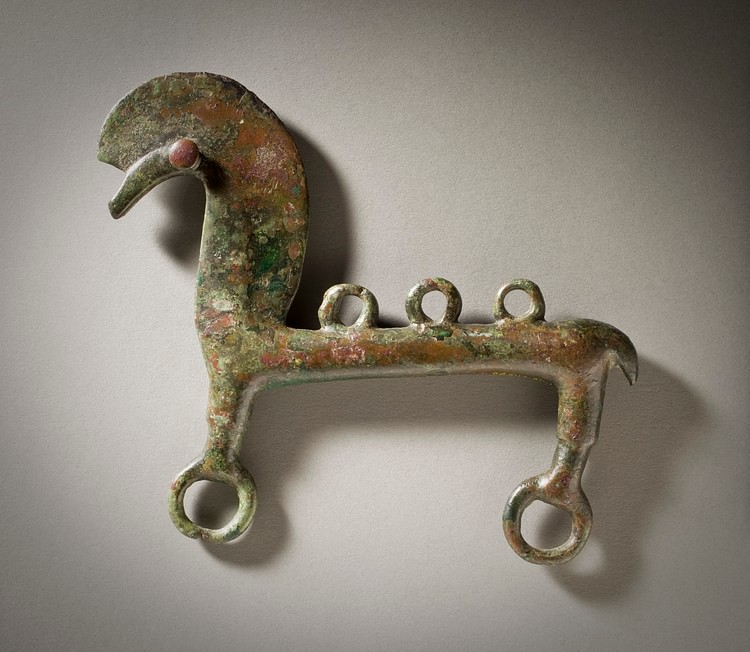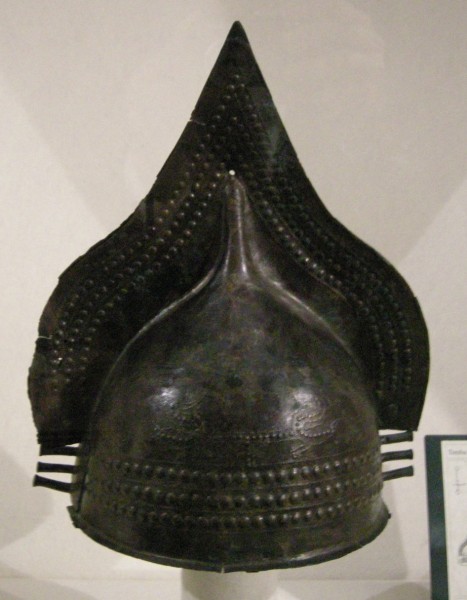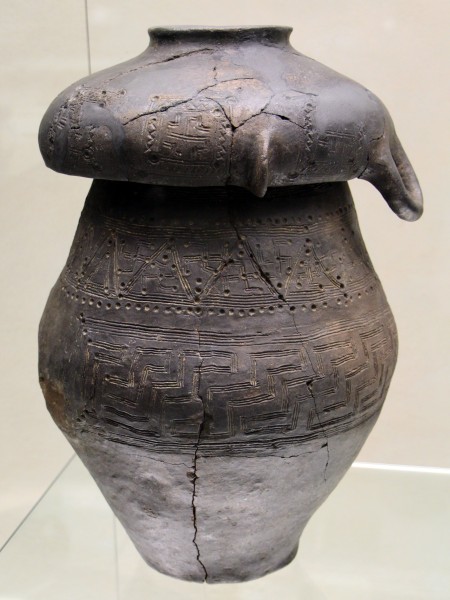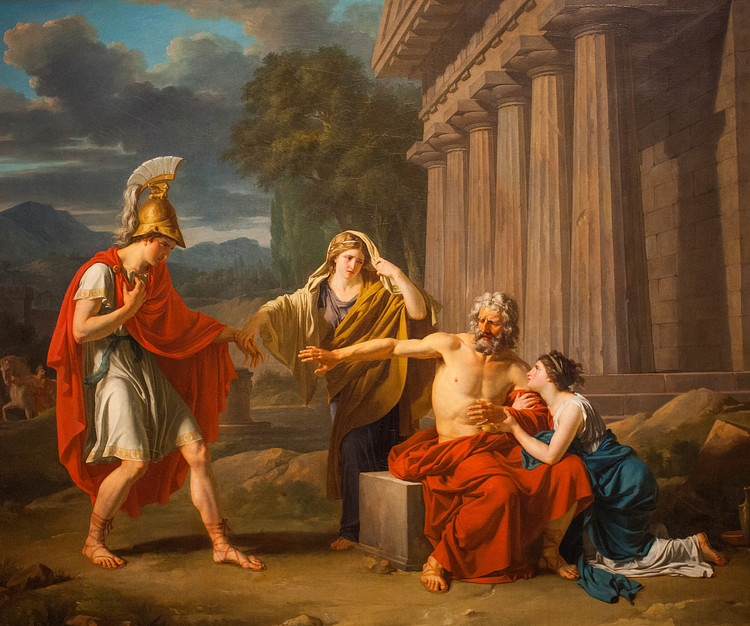Villanovan Culture › Oedipus at Colonus » Ancient origins
Articles and Definitions › Contents
- Villanovan Culture › Antique Origins
- Oedipus at Colonus › Antique Origins
Ancient civilizations › Historical and archaeological sites
Villanovan Culture › Antique Origins
Definition and Origins

The Villanovan culture flourished during the Iron Age in central Italy from c. 1000 to c. 750 BCE. It was a precursor of the Etruscan civilization, although the two populations are actually the same and the term Villanovan should not imply a separate people. Rather, the Villanovan culture is a label of convenience used by historians and archaeologists to describe the Etruscans in their formative years during the Iron Age.
ORIGINS & EVOLUTION
The name Villanovan derives from that of the estate owned by Giovanni Gozzadini near Bologna on which excavations were first made in 1853 CE. Eventually, traces of the Iron Age Villanovan culture, principally in the form of cemeteries, were discovered over a wide area of western central Italy and part of the north.
Between c. 1100 and 900 BCE, in a period known as the Proto-Villanovan, the culture prospered based on agriculture (cereals and legumes), hunting and animal husbandry (sheep, goats, cattle, and pigs). Central Italy also had an abundance of copperand iron. These benefits led to an increase in population, urbanisation, and social stratification, leading to the Villanovan culture proper. Settlements developed on easily defendable plateaus such as at Cerveteri, Tarquinia, Veii, and Vulci, or on hilltops as seen at Populonia and Chiusi. All of these Villanovan villages would eventually become important Etruscantowns.
HOUSING WAS MADE OF WATTLE & DAUB OR SUN-DRIED MUD BRICK WITH WOODEN POSTS FOR SUPPORT & THATCH ROOFS DECORATED WITH TERRACOTTA ADDITIONS.
VILLANOVAN HOUSING
Housing – rectangular, oval, and circular – was made of wattle and daub or sun-dried mud brick with wooden posts for support and thatch roofs with projecting eaves. In many cases, the holes for the posts and trenches cut into the foundation rock to support the walls remain in situ. Huts vary in size from the smallest, which would have housed a single family, to the larger rectangular type measuring up to 13 x 7 metres and so big enough for up to 10 people. Some huts had large pottery jars for food storage sunk into their floors, and there are also rock-cut drainage channels around buildings to drain off rainwater which was collected in communal reservoirs.
Models of the houses were made to contain the ashes of the deceased, and perhaps imitating real architecture, some of these have decoration on the exterior walls of geometric patterns and an aperture above the door for releasing smoke. They also have roof decorations, probably imitating the terracotta additions so typical of later Etruscan architecture but also carved from wood.

Villanovan House Funerary Urn
METALWORK, MIGRATION & TRADE
The horse was especially important to these peoples, as seen in the many finds of horse fittings and frequent representations in art. The quality of metalwork in bronze and pottery suggest a class of artisans dedicated to their production. Higher quality grave goods in some burials indicate the beginnings of a societal elite. A belief in an afterlife is suggested by the presence of miniaturised everyday items and tools – usually knives, weapons and armour for men, and weaving paraphernalia for women, although, in some cases vice-versa, suggesting a more active role for women in Villanovan society and the possibility that men, too, made clothing. As towns prospered, populations increased as seen in the expansion of cemeteries. A consequence was a greater competition for resources and land between towns, and many created new colonies to the north, south, and west of central Italy.
Evidence of trade between Villanovan centres is seen in finds of centre-specific manufactured goods discovered in contemporary towns. The culture was also in contact with the wider Mediterranean via the arrival of Greek settlers (especially Euboeans) in the mid-8th century BCE. These colonists were eager to exploit the mineral rich region of what would become Etruria. Bronzeworks also indicate contact with Sardinia, central Europe, and the Balkans. These links brought about a more advanced metallurgy, and the presence of Greeks specifically is attested by many finds of Greek pottery as well as local pottery made in imitation of it.

Villanovan Bronze Helmet
ARCHAEOLOGICAL FINDS
Villanovan cemeteries, located on hilltops or ravines just outside the community, contain burials of cremated remains in urns which are biconical (two vases with one smaller one acting as a lid for the other) and often carry simple incised decoration of geometric patterns, whirls, and swastikas, or even simple human 'stick' figures. Some urns have metal strips applied as decoration using lead or tin. One rarer type of urn, instead of a ceramic lid, has a bronze helmet on top with an impressive angular crest and embossed decoration. The urns were placed in shallow pits and accompanied by goods, as mentioned above.
A later type of burial was inhumation in trench tombs, sometimes with the body placed in a wooden or stone sarcophagus.Some such coffins at Populonia contained couples, and the same site has the first evidence of chamber tombs. Built in the late 9th century BCE using limestone slabs, they are the precursor of the more ambitious Etruscan tombs from the following century. Such lavish burial practices for only a few members of the community indicate a more complex society and separate elite class. In northern Villanovan settlements, such as near Bologna, tomb markers were made of stone and carved with reliefs. Typically with a rectangular base and circular top portion, they show scenes with animals, sphinxes, and geometric patterns. Depictions on these and other Villanovan artefacts of a 'Mistress of the Animals' – a female holding a quadruped in each hand – suggest a female nature deity was the focus of any religious practices.

Villanovan Biconical Funerary Urn
Pottery was made by hand, not on the wheel, and used unpurified clay fired at a low temperature producing the primitive wares known as impasto. Bronze goods include belts, buckles (some with inlaid glass beads), pins, sewing needles, spindles, loom weights, bracelets, earrings, urns, razors, cuirasses, shields, helmets, and arrowheads (often miniaturised). Jewellery other than bronze pieces includes gold hair spirals; earrings and fibulas made from Baltic amber ; and necklaces with beads made from bone, faience, and striped blue and white glass paste.
Analysis of the cremated and buried remains at Villanovan sites has revealed that life expectancy was no more than 50 years of age and the diet was generally short of protein. More vegetables were eaten than meat, but the range of foodstuffs consumed included fruit, nuts, fish, peas, broad beans, barley, and emmer. The latter was roasted, pounded, and boiled into a porridge to become the staple dish of the region.
MATURITY TO ETRUSCAN CULTURE
The Villanovan culture, as we have seen, underwent what is known as an 'orientalising' process where art and culture were influenced by contact with Greece, Phoenicia, and the Near East. From here the people of central Italy matured into the Etruscan culture proper; first in the south and then northwards, and from coastal areas to inland settlements. There is no evidence of a migration of peoples or warfare in the region at this time and so the rather unfortunate name of Villanovan Culture would, perhaps, be better termed Proto-Etruscan. This process of cultural evolution, datable by grave goods, was complete by the early 7th century BCE in the south of Etruria. In parts of northern Italy (around the Po Valley), more isolated from the wider Mediterranean, the Villanovan culture would persist until the 6th century BCE. The Etruscans would go on to prosper until the 2nd century BCE and their conquest and eventual cultural assimilation by the Romans.
MAP
Oedipus at Colonus › Antique Origins
Definition and Origins

Oedipus at Colonus was the third play of the Oedipus trilogy written by the great Greek tragedian Sophocles (c. 496 - c. 406 BCE). Although written in the years prior to his death, it would finally be presented by his son Iophon at a dramatic competition in 401 BCE. The play's sequel Antigone was actually written years earlier in 441 BCE. Oedipus at Colonusaccounts for the final years of the fallen king, 20 years after his exile from Thebes. Blind, weak and dressed in rags, he accepted his fate and wandered from town to town as an outcast accompanied only by his young daughter Antigone. Arriving outside Athens at Colonus, he is befriended by the king of Athens, Theseus, who offers him protection. Oedipus speaks of a prophecy that says whatever city grants him sanctuary will be given special protection. Knowledge of this prophecy comes to the attention of Creon, his brother-in-law, and his son Polyneices who want to take advantage of the blinded king. Both had coldly refused him shelter in the past but now travel to Colonus to offer him sanctuary.
SOPHOCLES
Along with Aeschylus and Euripides, Sophocles represents the greatest of the Greek playwrights. In the 4th and 5th centuries BCE, Greek tragedians performed their plays in outdoor theaters at various festivals and rituals in a series competitions. The purpose of these tragedies was to not only entertain but also to educate the Greek citizen, to explore a problem. Along with a chorus of singers to explain the action, there were actors often three (later four or more and always male) who wore masks and costumes. Although he was often considered a passionless observer of life, classicist Edith Hamilton in her book The Greek Way believed Sophocles was the embodiment of what we believe to be Greek. “He is direct, lucid, simple, reasonable. Excess - the word is not to be mentioned in his presence. Restraint is his as no other writer's” (199).

Sophocles
Sophocles was born into a wealthy family in the small Athenian suburb of Colonus, the site of his play. He was active in Athenian public life serving as treasurer, general and envoy. Later, because he was so respected, he became a member of a group of magistrates given the task of organizing finances and domestic affairs after the disastrous defeat of Athens at Syracuse (412-411 BCE). Although active in Athenian political circles, his plays rarely contain any references to current events or issues, making the dating of his plays difficult. He had two sons (one by his wife and one by his mistress); Iophon and Ariston both became playwrights.
THE MYTH
THE PURPOSE OF THESE TRAGEDIES WAS TO NOT ONLY ENTERTAIN BUT ALSO TO EDUCATE THE GREEK CITIZEN.
All three plays are based on an old myth which was quite familiar to the audience. In Oedipus the King, Oedipus fulfills a prophecy that foretold that he would murder his father and marry his mother. At Oedipus' birth, his father, hoping to avoid his own fate, had his son taken away. Providence, however, interceded, and the young boy was raised by the king and queen of Corinth. Unfortunately, Oedipus learned of the prophecy and unknowingly believing it meant his adoptive parents, he left Corinth. On route to Thebes, he got into an altercation and killed a man who happened to have been the Theban king, his real father. Upon arriving in the city, he saved the people by solving the riddle of the Sphinx and was rewarded by marrying the now-widowed queen (his mother). Years later when the truth was finally revealed, the queen committed suicide and Oedipus blinded himself and went into exile. Although Sophocles chose to exile Oedipus, various authors have viewed the outcome differently; both Homer and Euripides have him remain in Thebes although relinquishing the throne. Now, in Sophocles' final play the story continued as Oedipus realized that he was near death and decided to choose a final resting place.
CHARACTERS
Oedipus at Colonus has a rather small cast of central characters:
- Oedipus
- his daughter Antigone
- his other daughter Ismene
- Theseus
- Creon
- Polyneices
- a stranger
- a messenger
- and, of course, the chorus.
To many, the Oedipus in Oedipus at Colonus is not the same character as in Oedipus the King. Paul Roche in his translation of the Oedipus plays believed in Oedipus at Colonus the former king finally accedes to his fate and thereby rises to a restored sense of dignity, becoming a vehicle of divine justice. To Michael Grant in his The Classical Greeks, the storyline of Oedipus has been modified so that the former king does not sin but has been sinned against. Editor Moses Hadas in his book Greek Drama said that at the time of the play's writing Athens was beginning its gradual decline, and Sophocles returned to the story of Oedipus as a farewell to both the city and the stage. Theseus is included in the play “to glorify Athenian traditions of justice and generosity…” (167).
THE PLOT
The play begins at a grove in Colonus just outside Athens. As Antigone and Oedipus enter the grove, the former king turns to his daughter and says:
My daughter - daughter of the blind old man - where have we come to now, Antigone? What lands are these or holdings of what city? Who will be kind to Oedipus this evening and give alms to the wanderer? (145)
Recognizing the area as Athens, she describes the grove to her father and guides him to a large, flat rock. A lone stranger approaches from a distance and reprimands Oedipus for sitting on the rock, for it is considered to be holy, an area dedicated to the master horseman Colonus. He tells them that they must move and informs them that the land is governed by Theseus, son of Aegeus. Oedipus requests that the stranger go and seek Theseus, telling him that a little kindness will gain him much. After the stranger leaves, Oedipus turns to Antigone and says:
I have first bent my knees in this new land, therefore be mindful of me and of Apollo. For when he gave me oracles of evil, he also spoke of this, a resting place I should find home among the sacred Furies ; that I might round out there my bitter life. (150)
He tells her that the place that accepts him will receive benefits but the ones that have driven him away will be cursed. After Antigone and Oedipus move away from the sacred rock, the chorus enters (they had been sent by the stranger) and, upon seeing the father and daughter, immediately asks the old king and daughter to come forward. They tell Oedipus to identify himself. Oedipus only replies that he is an exile and begs them not to ask anything more. After further questioning, he finally admits that he is the ruined Oedipus and adds that he is cursed. Their reaction is immediate: "Away with you? Out with you? Leave our country.” (156) Oedipus pleads with them to give him shelter. Antigone speaks on her father's behalf asking them to have mercy on a beaten man. Understanding Oedipus' plea, they decide to leave the matter in the hands of Theseus.

Theatre Masks
As they wait for Theseus' arrival, Ismene, Oedipus' second daughter, appears, bringing news from Thebes. Her brother Polyneices has been betrayed, stripped of his power and exiled, fleeing to Argos where he hopes to raise an army and return to conquer Thebes. With the problems brewing in Thebes, Ismene wonders how long it will be before the gods have pity on him. She speaks of a prophecy from the Delphi oracle that says “… you shall be much solicited by our people before your death - and after - for their welfare” (163). She adds that the gods that once threw him out will now sustain him. Over time Oedipus has realized that he had acted hastily and now understands that his punishment has been far greater than his crime.Ismene warns him that Creon is on his way to take him back to settle him near Thebes. Hearing the conversation between Ismene and Oedipus, the chorus leader speaks:
Oedipus, you are surely worth our pity: you, and your children, too. And since you claim also to be a savior of our land, I'd like to give you counsel for good luck. (167)
Soon after Ismene leaves, Theseus arrives at the grove and immediately recognizes Oedipus. He wonders what the old blinded king wants. Oedipus speaks of his sons and the family curse and how the Delphi oracle compels them to summon him.Realizing his plight, Oedipus asks only to remain in Athens.
I was expelled from my own land by my own sons, and now, as a parricide, my return is not allowed. [...] Here I shall prevail over those who banished me. (174, 176)
Theseus promises that he will not betray Oedipus and no one will be allowed to take him against his will. Soon after Theseus leaves, Creon approaches with a number of soldiers. He advances towards Oedipus, Antigone, and the chorus. He turns to Oedipus and asks him to come home:
I see from your eyes that my arrival has been a cause of sudden fear to you. Do not be fearful and say nothing hostile. I have not come for any hostile action. [...] I grieve for your unhappiness, old man. I see you ravaged as you are, a stranger everywhere, never at rest with only a girl to serve you in your need. (180-181)
He says that poor Antigone has been leading a beggar's life, never knowing marriage; it is a disgrace. Of course, Oedipus does not believe him, calls him a rascal, and asks him to leave him and his daughter alone. However, Creon gives him a dire warning and informs him that he has already taken Ismene captive. His soldiers grab Antigone. The soldiers drag Antigone away, and as Creon grabs Oedipus, Theseus arrives with a small army of his own. He is told that Antigone and Ismene have been taken prisoner. Turning to Creon, he warns him:
You shall never leave this land of Attica until you produce those girls here in my presence. (190)
Creon responds saying he did not know Athens was a place for exiles. He claims that Oedipus had placed a curse on him and his people; it was an injury that deserved retaliation. Theseus tires of Creon's excuses, and shortly after Theseus and Creon leave, the Athenian king returns with both Antigone and Ismene. Oedipus is elated:
I have what is dearest to me in the world to die now would not be so terrible since you are near me. (197)
However, his happiness is short-lived, for he received word that a man claiming to be a relative has been asking about him in Athens. Theseus said the man was found praying at the altar of Poseidon. Oedipus realizes that it must be his son Polyneices. Antigone begs his father to listen Polyneices, and Oedipus agrees. Polyneices arrives and addresses his father.He tells them that he is a fugitive, too. He was banished from Thebes and had found asylum in Argos, where he hopes to raise an army and return to Thebes. He asks for forgiveness and begs his father to come with him. He will defeat his brother and bring Oedipus home to Thebes. Oedipus rejects his offer and informs him that he will not defeat his brother. Polyneices will die by his brother's hands, and his brother will die by his.
I abominate and disown you wretched scum. Go with this malediction I here pronounce for you that you will never master you native land by force of arms. (207)
As Polyneices departs, Oedipus and his daughters hear thunder. Oedipus realizes that the end is near and asks for Theseus in order to give him his blessing and fulfill his promise for Athens. The thunder is from Zeus, and it is a sign that it is time for him to die. Speaking to his daughters, he tells them that he will take only Theseus with him to the place where he will die, and adds that the Athenian king must not disclose it to anyone. Oedipus takes his daughters and Theseus to where the angel of death, Hermes, and Persephone lead him.

Greek Tragedy Mask
Shortly, a messenger arrives to speak to the chorus. Oedipus is dead. He tells of the old king's final moments. With his daughters weeping, he told them they no longer had to bear the burden of caring for him, but he reminded them that they were not to witness his death. Theseus was the only one permitted to stay and see his final resting place. Later, when Theseus returned to a solemn Antigone and Ismene, they asked if they could see his final resting spot, but he said no. Antigone regrettably accepts her father's last wishes and simply adds that she will return to Thebes with a hope to stop the war between her brothers.
OEDIPUS REDEEMED
As he approached his own death, Sophocles wrote the play as the long and unpopular war between Sparta and Athens was being fought and Spartan forces sat on the edge of the city. The play was a final homage to his city and beloved stage. In Oedipus at Colonus the blinded, fallen king dies. After 20 years as an outcast, Oedipus had arrived at Colonus with the hope that his odyssey was finally at an end. However, his death was not to be in vain. He was befriended by Theseus who was promised that Athens would receive special protection for having granted him sanctuary. Unfortunately, he learned that he was being pursued by his old nemesis Creon and his treacherous son Polyneices. In the end, he and his daughters were saved, and he finally found the rest that he had sought. In Oedipus at Colonus, he came to realize that his suffering far exceeded his crime. He had acted in haste. Now, as he approached his death, he understood that he was not the victimizer but a victim. He was able to die with a restored sense of dignity.
LICENSE:
Article based on information obtained from these sources:with permission from the Website Ancient History Encyclopedia
Content is available under License Creative Commons: Attribution-NonCommercial-ShareAlike 3.0 Unported. CC-BY-NC-SA License